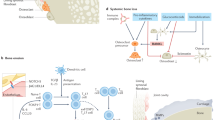Abstract
Rheumatoid arthritis (RA) is an inflammatory disease targeting the synovial membrane and extra-articular tissues. The most feared consequences are significant levels of pain, functional disability, and rheumatoid organ involvement. Molecular investigations of RA have markedly changed the understanding of the pathogenesis although the etiology remains unresolved. Despite the failure of intense efforts to confirm the presence of an infectious micro-organism in rheumatoid synovium, the concept that RA is infectious in origin has continued to be attractive. Theories on the autoimmune nature of RA have benefited from the enormous progress made in understanding the cellular and molecular components of normal immune responses. However, convincing experimental evidence of a joint-specific endogenous antigen in the synovial lesions is still lacking. The viewpoint that RA represents the sequelae of systemic lymphoproliferation has recently been supported by the finding of autoreactive T cells with atypical growth and differentiation behavior. Significant cross-fertilization for the understanding of RA can be expected by studies elucidating cell cycle control and the role of proto-oncogenes. The realization that RA is a genetic disease has had and will have a major impact on investigating pathological events. As in other common genetic disorders, multiple genetic determinants contribute to the risk of an individual developing chronic inflammatory rheumatoid synovitis. Individual genetic elements are seldom mutated or abnormal, but a risk threshold is reached by their accumulation and combination. Genes encoded in the HLA region are recognized as RA risk genes. Recent studies have emphasized that a gene dosing effect for RA-associated HLA alleles is functional, and that HLA polymorphisms act as progression factors rather than as initiation factors in the disease process. These data have challenged the traditional paradigm that disease-associated HLA molecules function solely through their capability to select, bind, and present an arthritogenic antigen. Current efforts focus on identifying the spectrum and nature of genes associated with various RA phenotypes. The future will likely see a broadening of biological systems involved in the pathogenesis of RA with anomalies other than immunoresponsiveness contributing to mechanisms driving articular and extra-articular RA.
Similar content being viewed by others
Author information
Authors and Affiliations
Additional information
Received: 22 November 1996 / Accepted: 20 March 1997
Rights and permissions
About this article
Cite this article
Weyand, C., Goronzy, J. The molecular basis of rheumatoid arthritis. J Mol Med 75, 772–785 (1997). https://doi.org/10.1007/s001090050167
Issue Date:
DOI: https://doi.org/10.1007/s001090050167




